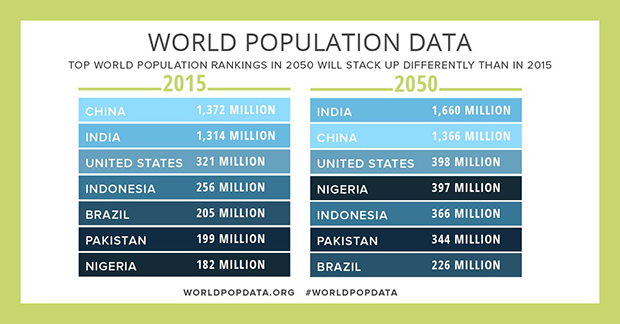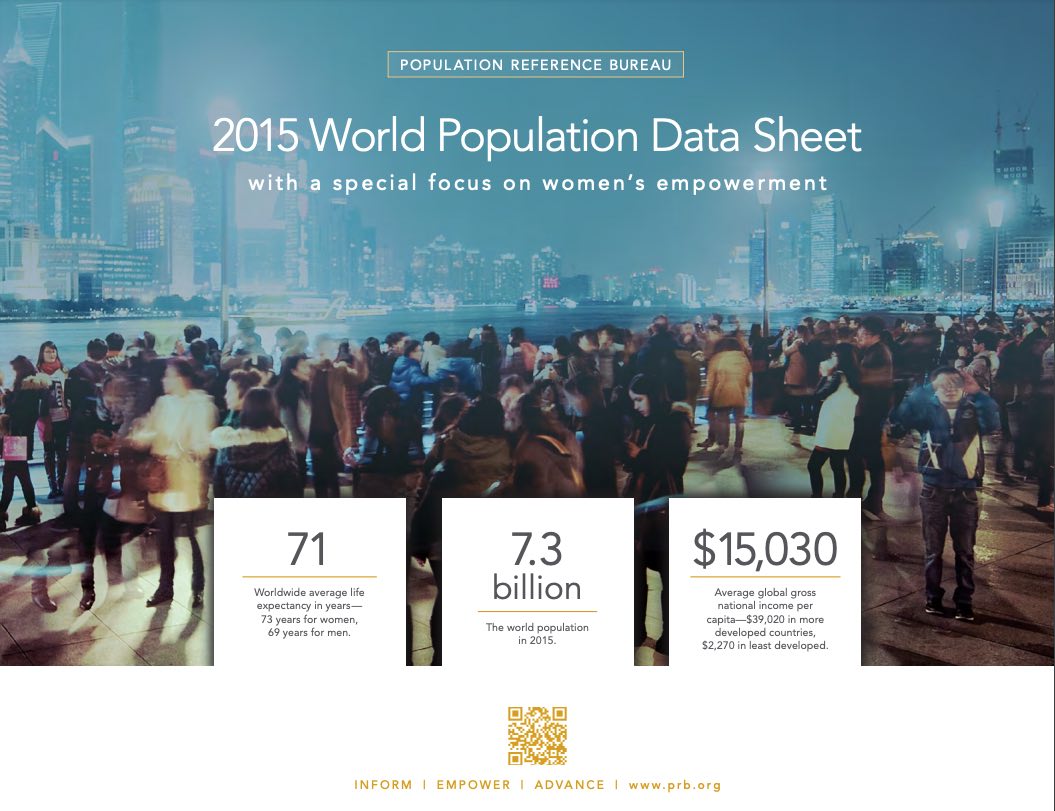
2015 World Population Data Sheet
Data Show Gains For Women, But More Progress Needed
Women worldwide are achieving gains in key barometers of personal well-being, but far more progress is needed to foster real gender equality and empower women, according to the Population Reference Bureau (PRB).

These findings are based on the 2015 edition of PRB’s annual World Population Data Sheet and a related package of interactive data features, all produced by PRB and released today at worldpopdata.org.
This year’s Data Sheet provides the latest data on 20 population, health, and environment indicators for the world, major regions, and more than 200 countries. It includes a special set of indicators and analytical graphics aimed at assessing the state of women’s empowerment globally.
“Women’s empowerment is when women and girls have the power to act freely, to exercise their rights, and to be full and equal members of society,” said Jeff Jordan, president and CEO of PRB. He added: “We’ve seen a lot of progress in recent years, but impediments remain in critical areas for women. They also need guarantees that they’ll receive equal reward for equal effort to men.”
For example, PRB analysis shows that earnings gaps between men and women persist despite women’s educational gains. In the United States, where women have closed the gap with men in college completion—and are actually outpacing men in the 25-to-29 age group—women with a bachelor’s degree or higher earn an average of only 73 percent of what male counterparts earn.
Globally, acceptance of gender-based violence remains a barrier to empowerment. For example, tolerance of wife beating has declined in a broad sense over the past several decades but remains alarmingly high in many countries, even among women themselves. In Indonesia and Zambia, 24 percent and 30 percent of women, respectively, agree that a husband is justified in beating his wife if she leaves the house without telling him. These levels are about twice as high as rates among men in these countries.
And, despite declining rates of marriages of girls at young ages, this practice is far from disappearing. In Bangladesh, the most recent data show 65 percent of Bangladeshi females married by age 18 and 29 percent married by age 15. In Niger, 76 percent are married by age 18 and 28 percent by age 15.
Worldwide, only one in five national parliamentarians are women. Regional rates range from 18 percent in Asia to 25 percent in Europe. Rwanda tops the list of female parliamentarians at 58 percent.

Meanwhile, PRB’s population projections in the 2015 Data Sheet show world population reaching 9.8 billion by 2050, up from an estimated 7.3 billion now, though the projections mask wide variations among countries, notably:
- National populations are projected to more than double in 40 countries, the vast majority of which are in Africa. Niger’s population is projected to more than triple.
- Thirty-four countries are projected to have smaller populations in 2050 than they do today. The biggest absolute decline would be in Japan, shrinking by 30 million people, while the biggest percentage decline would be Latvia, falling by 30 percent.
The Data Sheet’s global indicators on women’s empowerment also show that:
HEALTH:
- Women’s life expectancy averages 73 years globally, compared to 69 for men. Women’s average life expectancy is 82 years in the world’s more developed countries and only 63 years in the least developed. Lesotho, a small country in southern Africa affected by HIV/AIDS, has the world’s lowest average life expectancy for women, at 46 years.
- Maternal deaths averaged 136 per 100,000 births in 2013 (the latest year for which global data are available), down from 269 in 1990. While rates have fallen generally around the world, surprisingly, some developed countries have shown upswings. The rate in the United States was 28 deaths per 100,000 births in 2013, up from 12 in 1990.
ECONOMIC LIVELIHOOD:
- Financial inclusion of women is expanding globally, providing more women with access to affordable, convenient ways to save and borrow money to gain financial independence. But women continue to lag behind men in rates of financial inclusion in most less developed and least developed countries.
- Women’s share of nonagricultural employment shows marked regional differences. Women in African countries make up 30 percent, on average, of nonagricultural workers, compared to 44 percent in Latin America and the Caribbean, 25 percent in Asia, 48 percent in Europe, and 48 percent in Northern America (the United States and Canada). Moldova, in Eastern Europe, has the highest rate at 55 percent.
EDUCATION:
- Women’s educational attainment at higher levels varies substantially. In the least developed countries, there are only 66 females enrolled in tertiary education for every 100 males enrolled, while female enrollees outnumber male enrollees by 125 to 100 in more developed countries.

 ">
">
 ">
">